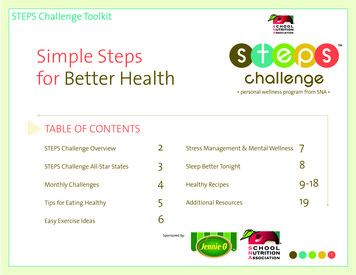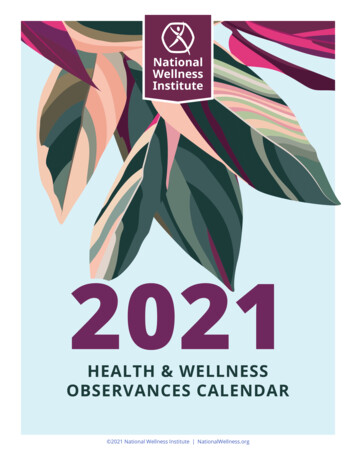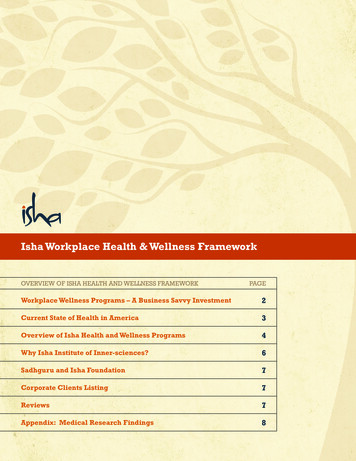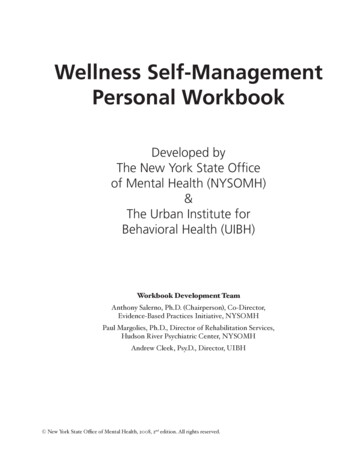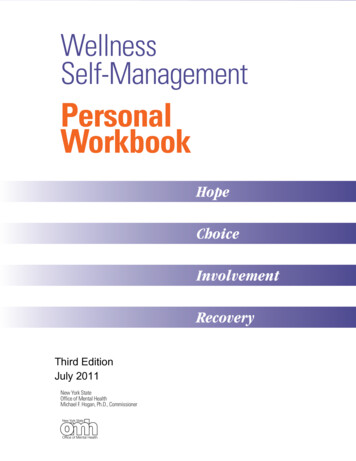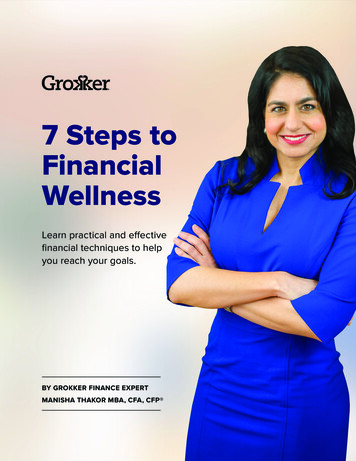
Transcription
7 Steps toFinancialWellnessLearn practical and effectivefinancial techniques to helpyou reach your goals.BY GROKKER FINANCE EXPERTMANISHA THAKOR MBA, CFA, CFP
CONTENTSWelcome to Grokker’s 7 Steps to Financial Wellness program! If you’re here,you’ve likely experienced at least a little stress over your financial situation. Knowthat you’re not alone.That’s why we partnered with financial guru, Manisha Thakor, to design a goat-your-own-pace program that will help you identify and tackle your financialtrouble-spots. Manisha will share valid, unbiased information and actionableadvice at each step of the way in order to help you start feeling a sense offinancial well-being now and in the future.By the end of this program you will understand exactly how much money youhave coming in, where it’s going out, and how to make the smartest choices aboutyour money moving forward.Here are the key 7 financial habits this program will help you master:Learn How To Live Within Your MeansBudget With The 50/30/20 Rule Practice Joy-Based SpendingDeal With DebtBuild An Emergency Cash FundSave For Retirement Talk Money With Your Honey Be sure to take advantage of the exercises outlined at each step andremember, building healthy financial habits is absolutely essential toreducing stress and setting yourself up for long-term success.7 Steps to Financial Wellnessgrokker.com
AUTHORABOUT MANISHA THAKOR, MBA, CFA, CFPA nationally renowned financial literacy advocate with an extraemphasis on women, Manisha Thakor is Vice President ofFinancial Education at the Seattle-based wealth managementfirm, Brighton Jones. Her mission is to help clients “Live ARicher Life” – literally and figuratively.Manisha is the co-author of two critically acclaimed personal finance books: ON MYOWN TWO FEET: a modern girl’s guide to personal finance and GET FINANCIALLYNAKED: how to talk money with your honey. Manisha is a member of The Wall StreetJournal’s Wealth Experts Panel, sits on Faculty at The Omega Institute, and serves onthe board of The National Endowment for Financial Education.Manisha’s financial advice has been featured in a wide range of national mediaoutlets including CNN, PBS, NPR, The Today Show, Rachel Ray, The New York Times,The Boston Globe, The Los Angeles Times, Real Simple, Women’s Day, Glamour,Marie Claire, Cosmopolitan and Women’s Health.Manisha earned her MBA from Harvard Business School in 1997 and her BA fromWellesley College in 1992. She is also a CFA charterholder and CFP practitioner.Manisha lives in Portland, OR where she revels in the Third Wave Coffee scene andthe stunning beauty of the Pacific Northwest. Her website is MoneyZen.com.7 Steps to Financial Wellnessgrokker.com
STEP 1LEARN HOW TO LIVE WITHIN YOUR MEANSEvaluating if you’re currently living within your means is by far the most importantfirst step to achieving financial wellness and it’s something many people strugglewith. If you regularly spend more money than you earn, you’ll always have financialstress unless you start making some changes right now. This means cutting downon unnecessary expenses so you have money remaining at the end of each month.For this exercise, answer the following three questionsto evaluate if you’re currently living within your means.Question #1:Are you up to date on your monthly expenses?If so, are you able to pay them for the next sixmonths?Question #3:Do you have enough money left over eachmonth after living expenses to set some aside forsavings?YesYesNoNoNot sureNot sureQuestion #2:Do you have debt? Do you carry over a balanceon your credit card each month? Do you continueto incur debt on your credit card that you areunable to pay off by the end of the month?YesNoIf you answered yes to #1, no to #2 and yes to#3, you are currently living within your means.If you have some work to do here, don’t stress.In Step #2 of the program we’ll take a dive intoyour monthly budget to see where adjustmentscan be made.Not sureIf you regularly spend more money than you earn,you’ll always have financial stress.7 Steps to Financial Wellnessgrokker.com
STEP 2BUDGET WITH THE 50/30/20 RULENow that you understand the importance of living within your means, it’s timeto balance your spending. The 50/30/20 budgeting rule will help you figure outwhere your money is being spent and determine where tweaks are necessary.People who are best positioned to roll with life’s punches are those whose after-tax takehome pay is broken up as follows: 50% to needs, 30% to wants, and 20% to savings.Needs:Your spending essentials such as essentialhousing, transportation, food, insurance,household items, and child care.Wants:You put everything else in here --- allthe “fun stuff” like eating out, going to amovie, or new clothes.Savings:In here you have your emergency fundsavings for unforseen circumstances,near term savings for things like a cardown payment or a wedding, and longerterm retirement savings.A simple way to evaluate how balanced your spending is at the moment is to jotdown what you KNOW to be true about your spending in each area (50/30/20).This will give you a rough sense of whether you are in - or out - of alignment. If youare out of alignment, don’t beat yourself up help is coming in the next step!Want to take a deeper dive into your budget?Pull up a chair and check out this helpful monthly budget template.7 Steps to Financial Wellnessgrokker.com
STEP 3PRACTICE JOY-BASED SPENDINGHow did the budgeting exercise go? If you identified an imbalance in your budgetduring the 50/30/20 exercise, you’ll find this next step super helpful.Step #3 is all about making any necessary adjustments to your budget using joybased spending. Implementing joy-based spending is simply the process of makingsure you are squeezing out the maximum amount of joy from each dollar youspend.In many cases, we’ve lost the connection between money and meaning in our life;this practice helps you get that clarity.Take some time to reflect on the following exercises before moving on to Step #4.Exercise 1: The Highlighter TestRefer to the 50/30/20 budget you createdand literally highlight the items in thelist you don’t find necessary or that donot bring you joy. You’ll notice some ofthe usual items like the cable bill at first-- here you have the opportunity to see ifyou can negotiate a lower payment plan.List out the items you highlighted anddecide how you want to adjust yourspending.But then the really interesting stuff kicksin -- you may notice you’re spendingmoney on extra things you don’t find joyin like a gym membership you don’t useor a dinner with people who you don’tlove spending time with.7 Steps to Financial Wellnessgrokker.com
STEP 3 CONT.Exercise 2: The Hourly Wage TestWhen you think about how many hours ofyour life it took to save up the money tobuy something, you really start thinkingtwice about your purchases.The first step in this test is to determinehow many hours you work each year. Forexample, in the US, many people workaround 2,000 hours a year (based on a40 hour work week with 50 weeks a yearon average).Now, the next time you see some 250outfit or electronic gizmo you feel youhave to have, you can do the math andask yourself if it’s worth more than 10hours of your efforts at work.What are a few items and experiencesyou’ve spent money on in the past monththat you don’t feel are worth the amountof work it took to pay for the items.Next, use that annual figure to determinewhat you’re earning per hour, before tax.Take your gross income and divide by2,000. So if you are earning 50,000 ayear, your hourly PRE-TAX wage is 25/hour.In many cases, we’ve lost the connection between money andmeaning in our life; this practice helps you get that clarity.7 Steps to Financial Wellnessgrokker.com
STEP 4DEAL WITH DEBTNow that you have a handle on your budget, it’s time to start tackling what isarguably the most stressful and confusing financial topic out there -- dealing withdebt. In modern society, debt is wrongly sold as “something you can’t live without”and getting access to a credit card or loan that you aren’t prepared to pay for iseasier than ever.A good rule of thumb when it comes to deciding whether to take on debt is - ifit increases your net worth or has future value, it’s a debt worth considering. Forinstance, a home mortgage or continuing your education.On the other hand, anything that decreases in value the minute you buy itbecomes bad debt. Unnecessary home goods like extra throw pillows forinstance. If those purchases aren’t coming out of your budgeted WANTS bucketfrom your 50/30/20 budget, then it’s time to make some changes.Remember, the longer you have debt in your life, the longer you’ll postpone doingthe things that make your money work for you.Use this three-step process to start whittling away at your debt:1. Start listing out all your current outstanding debt. Then, use the template below to reorderyour list by the debt with the highest interest rate on top.all the way down to the lowest.Next, make sure you are paying the minimum monthly payment on every one of your debts ontime. The best way to do this is to set up all your minimum debt payments on auto pay.7 Steps to Financial Wellnessgrokker.com
STEP 4 CONT.SourceDollar AmountOwedMin. MonthlyPaymentInterestRate2. Once you have your debt listed from highest to lowest interest rate, start adding anadditional 50, 100, or 150 a month to your minimum monthly payment on your mostexpensive debt until it is paid off in full. Where can you find that extra money, you ask? SeeStep #3 on joy-based spending OR consider taking on some type of part-time work on theweekends or doing odd jobs to raise those funds.3. When you’ve ticked down that list it’s time to celebrate and save! It’s no easy feat andthat recognition is important. When you’re done with your happy dance, it’s time to starttaking that money you were using for debt repayment and redirect it into a long term savingsaccount for your retirement. We’ll talk in more depth about retirement planning during Step#6 of the program!7 Steps to Financial Wellnessgrokker.com
STEP 5BUILD AN EMERGENCY CASH FUNDToday, we’re talking about the importance of building an emergency cash fundfor unforeseen expenses. While saving your money isn’t always the most funin the short term, it is one of the best steps you can take to create financialwellbeing and build for a brighter future.Don’t start contributing to your emergency fund until you’ve paid down yourcredit card debt. It’s important to pay down debt before you graduate to this step.Manisha advises aiming to save at least 2,000 starter emergency fund. Why 2,000? This figure comes from research showing that the average persontends to experience roughly 2,000 a year in unexpected expenses. Yourpersonal situation may be higher or lower, but 2,000 is a great place to startbased on nationwide averages. Over the long run you’ll want to eventuallybuild up an emergency fund equals to 3 to 6 months of your essential livingexpenses.Here’s how to get started:Time to refer back to that 50/30/20balanced spending rule once again.When you’re done paying off credit carddebt and starting to build your emergencyfund, a good chunk of your savingsmoney (the 20% bucket) will go first tocreating your initial safety buffer andeventually, a longer term fund.2. Slowly work, using the tools from thejoy-based spending exercise, to free up alittle extra cash each week to contributeto this fund until you hit the 2,000 mark.Write out your plan for budgeting to buildyour starter emergency cash fund of 2,000:Once you’re ready to get started, keepthese two rules of thumb in mind:1. Contribute whatever cash you can to itright away.7 Steps to Financial Wellnessgrokker.com
STEP 6SAVE FOR RETIREMENTRetirement in modern society is an interesting concept. Years ago people workeduntil age 65, retired, lived another 2-5 years, then passed away. With our modernlonger life spans, it’s now possible for someone to spend nearly as many years inretirement as they did working.The concept of preparing for retirement can feel daunting with this knowledge, sotoday we’re coaching you through how to effectively save for it. You can still be in agood place to start saving for retirement even when paying down your debt. You’llknow you’re ready to start once you have made the minimum monthly payments,are paying down an additional amount on your debt each month like we discussedin Step #4, and you’ve achieved your 2,000 minimum emergency fund.Estimates of how much you need to have saved for retirement are varied. A goodgoal to work towards is having at least eight times your ending salary by age 67 tomeet your basic needs in retirement.If you wait until your finances are perfect to get down to saving,you may never get going. Even if you are just starting by saving 25or 50 a month towards retirement, you’ll be on the right track.7 Steps to Financial Wellnessgrokker.com
STEP 6 CONT.Eight times your ending salary may sound daunting,so here’s are two ways to get started right now:1. Check with your HR department atwork to learn about your workplaceretirement plan options and make sureyou are participating as fully as you can.If your employer offers a program likethis and you aren’t taking advantage,you may be missing out on free moneybecause many companies “match” yourcontribution meaning the company willcontribute 0.50 or 1.00 for each 1.00you contribute, up to a certain point.If you don’t have a workplace retirementplan, consider opening an IRA.2. Using the timeline below, benchmarkhow you’re tracking compared to therecommended savings timeline for ahealthy retirement. If you’re behindschedule refer back to Step #3 on JoyBased Spending to see where you canmake some adjustments.Timeline*based on research by Fidelity Investments7 Steps to Financial Wellnessgrokker.com
STEP 7TALK MONEY WITH YOUR HONEYYou’ve made it to the final step of 7 Steps to Financial Wellness, amazing job!But before we say “goodbye”, it’s time to talk money with your honey. Finances arethe leading cause of stress, fights, and divorce in a relationship. So, making sureyou and your sweetie are on the same page financially is essential to the long-termhealth of your relationship.When you’ve found that special someone and are talking about future plans, takingthis quiz is a great way to foster a healthy discussion about your approach tofinancial health.Many people feel sharing this information can feel as awkward as sharing sexualpreferences — so if you are feeling uncomfortable, rest assured you are not alone.We recommend kicking off the conversation by discussing with each other that thewhole point of this exercise is NOT to judge. There are no right or wrong answers.The purpose of this exercise is to get a sense of each of your knowledge, interest,and behaviors around money — so that together you can come up with a “divide& conquer” game plan for how you plan to deal with money as a couple if youare in a committed relationship or identifying potential areas that need furtherdiscussion if you are still in the dating stage.Turn the page for the quiz.7 Steps to Financial Wellnessgrokker.com
STEP 7 CONT.Financial Compatibility QuizInstructions:Individually answer ‘Yes’ or ‘No’ to the questions below. When you’re done, gothrough each section and add up the number of times you answered ‘Yes’ to aquestion - and fill in the following chart to understand your financial compatibility.Total the Number of YES Responses per Section with the scorecard below. If thereare areas you find are lacking then you can start creating a game plan for how youwill rectify that. This can include watching more videos on Grokker to get tips, readingand discussing a finance book together, or talking with a financial planner.Knowledge1You know how much money you need to cover your regular monthlyexpenses2You know how much money you need for your personal 3-6 monthemergency fund3You know how much you should aim to save for retirement as apercentage of your income4You know where all of your money is stored today (all bank accountsand other financial accounts including retirement accounts)5You know how much money you owe for all your debt, and the interest rates you are being charged on each6You understand basic concepts regarding how to invest your money7You know how much risk you’re willing to take with your investments8You know what your top five financial goals are9You know the key types of insurance you need to protect your lovedones and assets10You know where your essential documents are stored7 Steps to Financial WellnessYesNogrokker.com
STEP 7 CONT.Behavior1You always pay your bills on time2You track your progress in terms of meeting your financial goals3You regularly look at your bank or other financial account balances4You are on track to save 10% or more of your before-tax income forretirement (if not today, you are committed to over time)5You are paying off debt in a planned, systematic way - i.e. starting withthe highest interest rate first6You regularly check your credit reports to make sure there are noerrors (or that identity theft has not occurred) and you know what yourcredit score is7Any money that you invest in individual stocks (not mutual funds) ismoney that you can afford to lose8You have a will or living trust and an appropriate loved one/trusteealso has a copy9You have enough insurance to cover your needs, including sufficientlife insurance if you have kids10You ask financial professionals for help when you need itInterests1You enjoy reading financial books, magazines, newsletters, or blogs2You enjoy watching financial TV shows or listening to radio programs3You enjoy talking about financial matters4You often think about your personal financial situation and how toimprove it5You often think about whether you are on track to meet yourretirement and other big financial goals7 Steps to Financial WellnessYesNoYesNogrokker.com
STEP 7 CONT.YesInterests (continued)6You are interested in the financial details of your day-to-day life7You believe money issues need to be addressed today, ratherthan letting them “resolve themselves” over time8You prioritize having financial security and stability in your life9You spend time thinking about protecting your assets10You believe having money leads to good outcomesYour ResultYour Partner’s ResultKnowledge/ 10/ 10Interest/ 10/ 10Behavior/ 10/ 10NoGreat job on completing this journey. We hope you’re feelingincreased calm, confidence, and clarity about your financialwell-being.7 Steps to Financial Wellnessgrokker.com
Marie Claire, Cosmopolitan and Women’s Health. Manisha earned her MBA from Harvard Business School in 1997 and her BA from Wellesley College in 1992. She is also a CFA charterholder and CFP practitioner. Manisha lives in Portland, OR where she revels in the Third Wave Coffee scene and .



